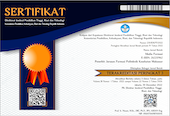Aktivitas Antibakteri Ekstrak Etanol Daun Jambu Putih (Syzygium malaccense (L.) Merr. & L.M. Perry) Terhadap Pertumbuhan Escherichia coli dan Streptococcus mutans
Abstract
White guava leaves (Syzygium malaccense (L.) Merr. & L.M. Perry) contain flavonoids, saponins and tannins which are used as antibacterial. This study aims to determine the antibacterial activity of guava leaf extract on the growth of Escherichia coli and Streptococcus mutans. The scope of this research is in the field of microbiology, where the research was carried out in the Microbiology Laboratory of the Department of Pharmacy, Polytechnic of the Ministry of Health, Makassar. Guava leaves are macerated with 96% ethanol. Testing the antibacterial activity of guava leaf extract using the agar diffusion method. This study used white guava leaf extract with a concentration of 2%, 4%, and 6%, positive control (ciprofloxacin) and negative control (Na. CMC) which then measured the inhibition zone diameter in Escherichia coli and Streptococcus mutans. The results obtained by Escherichia coli at a concentration of 2% were 12.3 mm, the concentration of 4% was 14.3 mm, the concentration of 6% was 18.67 mm, while the positive control was 23 mm and the negative control did not show any zone of resistance. Meanwhile, the results obtained by Streptococcus mutans at a concentration of 2% were 8.67 mm, a concentration of 4% was 11.67 mm, a concentration of 6% was 16.3 mm, while the positive control was 31 mm and in the negative control there was no visible zone of resistance. For ANOVA calculations using Graphad prism, P value(<0.0001) indicates significant with an F caunt of 307,7
Keywords: White guava leaves (Syzygium malaccense (L.) Merr. & L.M. Perry), antibacterial activity, Escherichia coli, Streptococcus mutans.
Daun jambu putih (Syzygium malaccense (L.) Merr. & L.M. Perry) memiliki kandungan flavonoid, saponin dan tanin yang digunakan sebagai antibakteri. Penelitian ini bertujuan untuk mengetahui adanya aktivitas antibakteri ekstrak daun jambu putih terhadap pertumbuhan Escherichia coli dan Streptococcus mutans. Ruang lingkup penelitian ini adalah bidang mikrobiologi yang dimana penelitian dilaksanakan di Laboratorium Mikrobiologi Jurusan Farmasi Poltekkes Kemenkes Makassar. Daun jambu putih dimaserasi dengan etanol 96%. Pengujian aktivitas antibakteri ekstrak daun jambu putih menggunakan metode difusi agar. Penelitian ini menggunakan ekstrak daun jambu putih dengan konsentrasi 2%, 4%, dan 6%, kontrol positif (ciprofloxacin) dan kontrol negatif (Na. CMC) yang kemudian dilakukan pengukuran diameter zona hambat pada Escherichia coli dan Streptococcus mutans. Hasil yang diperoleh Escherichia coli pada konsentrasi 2% adalah 12,3 mm, konsentrasi 4% adalah 14,3 mm, konsentrasi 6% adalah 18,67 mm, sedangkan pada kontrol positif adalah 23 mm dan kontrol negatif tidak terlihat adanya zona hambatan. Sedangkan hasil yang diperoleh Streptococcus mutans pada konsentrasi 2% adalah 8,67 mm, konsentrasi 4% adalah 11,67 mm, konsentrasi 6% adalah 16,3 mm, sedangkan pada kontrol positif adalah 31 mm dan kontrol negatif tidak terlihat adanya zona hambatan, untuk perhitungan anova menggunakan Graphad prism P value (< 0,0001) menyatakan signifikan dengan nilai F hitung 307,7
Kata kunci : Daun jambu putih (Syzygium malaccense (L.) Merr. & L.M. Perry), aktivitas antibakteri, Escherichia coli, Streptococcus mutans.
Full Text:
PDF (Bahasa Indonesia)References
Adrianis, Asmawi. 2017. Uji Aktivitas Antioksidan, Toksisitas dan Kandungan Fenolik Total dari Ekstrak Kulit Batang Jambu Bol (Syzygium jambos (L.) Alston). Diss. Universitas Andalas.
Eka , A. H. 2016. Formulasi Sediaan Gel Gigi yang Mengandung Ekstrak Etanol Daun Jambu Bol (Syzygium malaccense L.) Sebagai Penghambat Pertumbuhan Bakteri Steptococcus mutans. Skripsi. Garut: Universitas Garut.
Fajrina, Aulia. 2017. "Formulasi sediaan gel ekstrak etanol daun Jambu bol (Syzgium malaccense L. Merr & Perry) Sebagai pengobatan luka sayat."
Ganiswara SG,dkk. 2003. Farmakologi dan Terapi Edisi 4. Jakarta : Gaya Baru
Kemenkes R1. 2010. Farmakope Herbal Indonesia. Kementerian Kesehatan Repulik Indonesia.
Muthmainnah, B., and Andi Nilasari. 2018. "Uji Aktivitas Antimikroba Herba Daun Singkong (Manihot utilissima Pohl) Terhadap Pertumbuhan Bakteri Staphylococcus aureus." Jurnal Ilmiah Kesehatan Diagnosis 12.6 : 614-616.
Mutia, C., Fitrianingsih, S,P., Choesrina, R., 2017. Uji Aktivitas Antibakteri Ekstrak Etanol Daun Singkong (Manihot esculenta Crantz) Terhadap Bakteri Escherichia coli danbakteri Staphylococus aureus Secara In Vitro. Universitas Islam Bandung.Vol.3, No. 1.
Nurwaini, Setyo. 2019. "Hand Sanitizer Gel Kombinasi Ekstrak Daun Lidah Mertua Dan Daun Jambu Biji." Proceeding of The Urecol : 103-109.
Oktavia Putri, D. W. I. T. A. 2019. "Aktivitas Antibakteri Ekstrak Metanol Kulit Batang Tumbuhan Jambu Bol (Syzygium malaccense) Terhadap Bakteri Escherichia coli." UNESA Journal of Chemistry 8.2.
Sekeon Helen N, dkk. 2018. Uji Konsentrasi Hambat Minimum Ekstrak Daun Gedi (Abelmoschus manihot L.) terhadap Pertumbuhan Bakteri Streptococcus Mutans. Jurnal e-GiGi (eG), Volume 6 Nomor 1.
Todar K. 2012. Pathogenic E. coli. http://textbookofbacteriology.net/e.coli.html.
Ulung, Gagas, and Pusat Studi. 2014. Sehat Alami dengan Herbal: 250 Tanaman Berkhasiat Obat. Vol. 1. Gramedia Pustaka Utama.
Vebliani, Rinny, Noor Muthmainah, and Alfi Yasmina. 2020. "Perbandingan Aktivitas Antibakteri Ekstrak Daun Tanjung dan Daun Jambu Biji terhadap Escherichia coli In Vitro." Homeostasis 3.1 : 141-146.
Zeniusa popi dan M.Ricky ramadhian, 2017. Efektifitas Ekstrak Etanol Teh Hijau dalam Menghambat Pertumbuhan Escherichia coli. Universitas Lampung. Majority. Volume 7 Nomor 1.
Zelnicek, Tailor. 2014. Streptococcus mutans- Tooth Decay. Microbiology in Arezzo. Univ. Of Oklahoma. Italy.
DOI: https://doi.org/10.32382/mf.v17i2.2482
Refbacks
- There are currently no refbacks.

This work is licensed under a Creative Commons Attribution-NonCommercial-ShareAlike 4.0 International License.
Kontak Editor
Hendra Stevani
Jurusan Farmasi Poltekkes kemenkes Makassar
email : hendra@poltekkes-mks.ac.id

This work is licensed under a Creative Commons Attribution-ShareAlike 4.0 International License.





.png)


